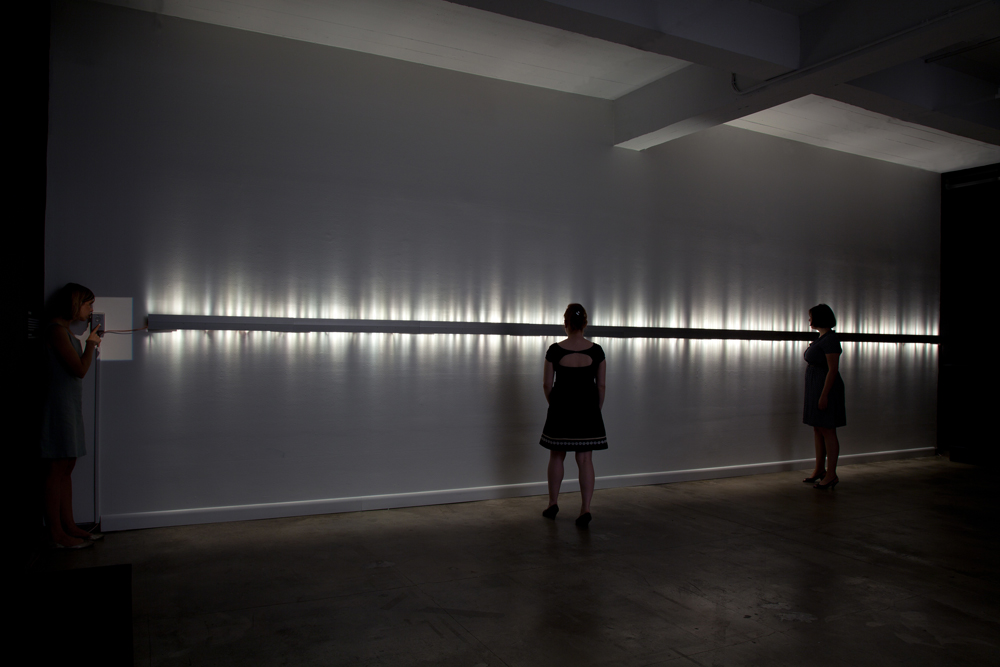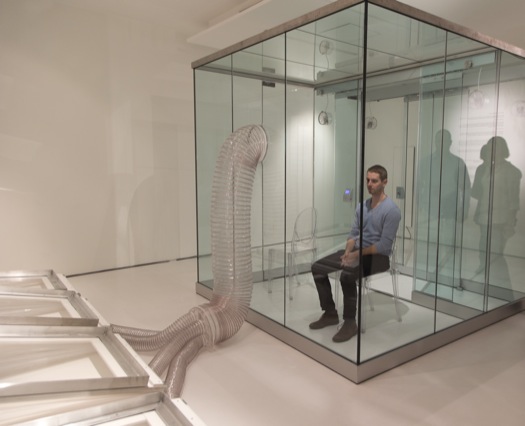Rafael Lozano-Hemmer is an electronic artist who works at the intersection of performance art and architecture. He believes that “even if you are not using a computer, you are affected by this environment. Working with technology is inevitable.” His studies in Physical Chemistry shaped has had a lasting impact on the form and structure of his art. He is best known for making interactive theatrical pieces in public spaces all over the world. “His installations seek to interrupt the increasingly homogenized urban condition by providing critical platforms for participation” He utilizes robotics, projections, LED’s, cameras, and tracking systems to make holistically interactive art.
Voice Array

This first piece, “Voice Array”, (2011) reminds me of a computer science queue. Each participant records their voice in an intercom, and those recordings are automatically translated into flashes of light, which are stored in the first light in the array. When the next voice is recorded, the original and all other recordings are pushed along the array one spot. The 288th recording, which has nowhere to move to, can then be heard by itself before disappearing.
Pan-Anthem

This piece, “Pan-Anthem”, (2014) is a customizable visualization of countries by their anthem. Individual speakers are magnetically attached to the wall, and each play the anthem of the country they represent, when the participant stands in front. The speakers are intended to be arranged according to some statistic, such as Population, GDP, number of women in parliament, or year of independence.
One configuration orders the country’s speakers by national military spending per capita. In this setup, the far left of the wall housed speakers for countries without military presences like Costa Rica, Iceland, and Andorra. The far right housed the US with a sizable separation between us and the next country. A separate wall contains countries that no longer exist, like Yugoslavia and Czechoslovakia.
Pulse Spiral

“Pulse Spiral” (2008) is a 3-dimensional spiral paraboloid of lights, arranged according to Fermat’s equation. an efficient spatial distribution along a surface. This organization can be found or the distribution of leaves and roots on plants in many other naturally occurring arrangements. The participant stands under the center of the piece, and hold onto handles which measure their heartbeat. The Participant looks up and watches their heartbeat spiral up through the lights.
Vicious Circular Breathing

“Vicious Circular Breathing” (2013-2014) is an interactive installation large glass sealed chamber. When the participant walks into the chamber, they are breathing the same stale air that all previous participants have breathed. It utilizes a decompression chamber to keep the chamber hermetically sealed, so people have been breathing the same air since its installation. Participants are made aware of the dangers involved including contagion and panic, before they can participate.

The stale air is passed through a large tube to 4 large bellows, inspired by an organ. The bellows creature pressure and vacuums to inflate and deflate 51 paper bags. This piece was intended to show how we all share the same air, water, and earth. The whole piece is a biometric portrait, and unlike most participatory art, there is no positive to participating. If you participate too much, you will actually die form oxygen depravation.
Open Air

This last project, “Open Air, Relational Architecture”, (2012) took place between September 20th and October 14th, in Philly’s Benjamin Franklin Parkway. It is construction of 24 powerful searchlights to create a unique dynamic light formation in the sky, which reacts to voice messages sent by participants using a mobile app. Anyone and everyone was invited to send messages of up to 30 seconds of just about anything. The piece gave priority to people in the parkway, but people who submit audio clips online were also included in the event. The recordings could be heard through speakers in the parkway, or online so that the event could be experienced from anywhere. The piece played many roles, that of a visible voicemail system, a “rant-line”, a public stage, and an archive of Philly past and present. The piece was intended to create a sense of global connect, complicity, and public agency.